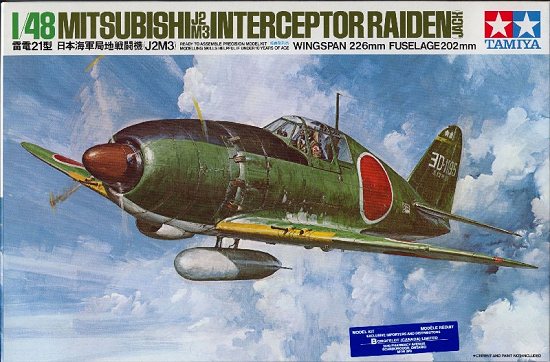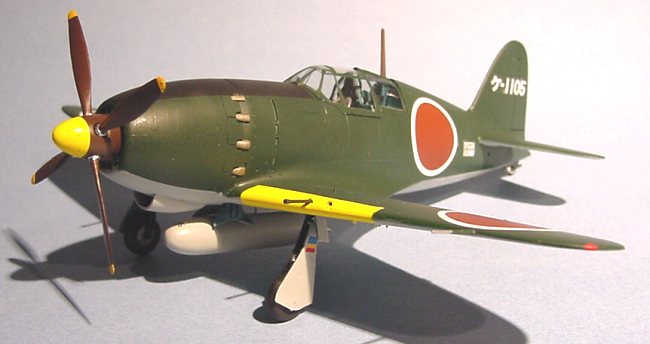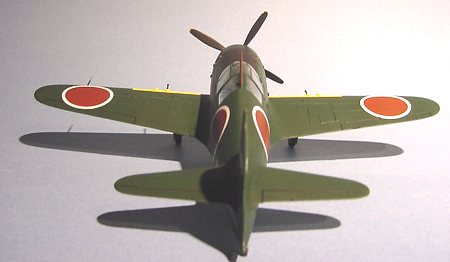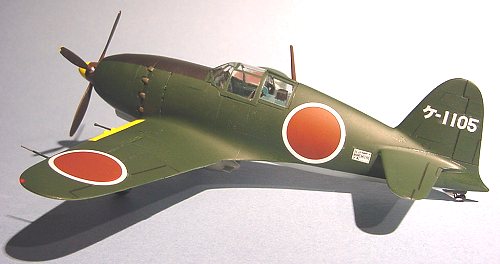
Tamiya 1/48 J2M3 "Jack"
|
KIT # |
61018 |
|
PRICE: |
CDN$12.99 |
|
DECALS: |
Three aircraft |
|
REVIEWER: |
Olivier Lacombe |
|
NOTES: |
(Kit is actually 1/50 Scale, Ed.) |

|
HISTORY |

What sets apart the Jack from the other WWII Japanese aircraft is that it was designed to climb quickly and go really fast, unlike the other aircrafts which were made to be really manoeuvrable. It was also the first pure Japanese interceptor, the result of the bombing of the Japanese homeland by American bombers. The aircraft was fitted with a laminar flow wing and the prototype was powered by a MK4C Kasei 13 engine developing 1460HP. The first tests were good, the fighter possessing good flight characteristics, but they were not absent from a number of problems. The most important one was that the forward view was very poor. Indeed, the prototype had been fitted with a low drag canopy, giving very little space for the pilot to look ahead, and the windshield was curved, thus distorting his vision.
 The production version of
the J2M1, as described above, was cancelled in favour of the refined design of
the J2M2. The new version had a new canopy which gave decent vision to the
pilot, the propeller was changed from a VDM 3-bladed to a 4 bladed and the
engine was upgraded to a MK4R-A Kasei 23a, which was equipped with
water-methanol injection to produce 1 820HP. The exhausts were also redesigned
to allow for thrust augmentation. Vibrations plagued the aircraft, and these
were solved only after mounting more resilient engine-mount shock absorber, and
by augmenting the rigidity of the propeller blades. The aircraft was also
subject to something much more troubling: it was found out that when the
undercarriage was retracted, the tail-wheel shock absorber pushed on the
elevator’s tube and pushed the controls full nose down! Vibrations continued to
hinder the use of the aircraft. One machine disintegrated in mid-air, after
either the engine broke loose from its mounts and broke the tail or one of the
cowlings went AWOL and did the same thing to the rear of the aircraft. Cowling
fasteners were strengthened, as were the engine-mount attachment points, but
Jacks disintegrated even after these modifications.
The production version of
the J2M1, as described above, was cancelled in favour of the refined design of
the J2M2. The new version had a new canopy which gave decent vision to the
pilot, the propeller was changed from a VDM 3-bladed to a 4 bladed and the
engine was upgraded to a MK4R-A Kasei 23a, which was equipped with
water-methanol injection to produce 1 820HP. The exhausts were also redesigned
to allow for thrust augmentation. Vibrations plagued the aircraft, and these
were solved only after mounting more resilient engine-mount shock absorber, and
by augmenting the rigidity of the propeller blades. The aircraft was also
subject to something much more troubling: it was found out that when the
undercarriage was retracted, the tail-wheel shock absorber pushed on the
elevator’s tube and pushed the controls full nose down! Vibrations continued to
hinder the use of the aircraft. One machine disintegrated in mid-air, after
either the engine broke loose from its mounts and broke the tail or one of the
cowlings went AWOL and did the same thing to the rear of the aircraft. Cowling
fasteners were strengthened, as were the engine-mount attachment points, but
Jacks disintegrated even after these modifications.
The main operational version was the J2M3a, featuring 4 20 mm cannons in the wings. At one point, a domed canopy was fitted, the aircraft being designated J2M6a. The aircraft was a good design, with fine all-around flying qualities, but, unfortunately for Japan, the sleeping giant awakened by Yamamoto was now in full gear, and the country of the Rising Sun had already lost the production war.
|
THE KIT |
This is one of Tamiya’s older offerings, but the parts moulding is excellent. Four light grey styrene sprues are bagged together, along with the canopy. There is little or no flash on the parts, and the lines are finely recessed. The parts in my sample are not warped, and the only sinkholes are on the outside of the gear doors, where they can easily be filled.
 The interior detailing is
good for a kit of this vintage (1973), with separate instrument panel and rear
bulkhead. The dash is flat, without any engraving, but Tamiya provides the
builder with nice decals for the instruments. The wheel wells are boxed in with
light detailing, the Superdetailers will want to put some hoses in there. You
can build the aircraft with the gears up or down, gear doors are provided for
both phases of flight.
The interior detailing is
good for a kit of this vintage (1973), with separate instrument panel and rear
bulkhead. The dash is flat, without any engraving, but Tamiya provides the
builder with nice decals for the instruments. The wheel wells are boxed in with
light detailing, the Superdetailers will want to put some hoses in there. You
can build the aircraft with the gears up or down, gear doors are provided for
both phases of flight.
The decal sheet is small, with all the colours in register, but they are the standard Tamiya decals: thick and rubbery looking. The three different planes go as follows:
- Genzan Flying Group based at Kagoshima air base in November 1943.
- One 302nd Flying Group machine at Atsugi air base, from March ’45 to August ’45.
- One 352nd Flying Group aircraft at Kanoya air base in April ’45.
All three are IJN Green over IJN Gray, but the last one features large yellow lightning bolts on the side of the fuselage.
|
CONSTRUCTION |
I started with the cockpit, painting the seat Testor Aluminium (small jar) and the rest Model Master Aotake Blue. I found out the hard way that this colour covers almost nothing, and after consulting the forum, Lee Kolosna kindly pointed out to me that an undercoat of Aluminium would solve the problem. I did try that on the cockpit roll bar, and it worked. Details were picked up with Flat Black, Chrome Silver and Olive Drab. I used the kit’s decal for the instrument panel, and the effect is quite convincing. The wheel wells were dealt with at this time, I chose Aotake Blue for their colour.
 I glued the wings
together, as well as the propeller shaft in the front cowling. I glued the
various bits in the cockpit (there is a transparent panel to be glued in front
of the decals, but it looks silly, so I just left it off), before gluing it on
the right fuselage half. The fit is excellent. Before joining the two halves
together, don’t forget to glue the tail wheel at its place under the rudder. I
forgot and had to separate the rear of the fuselage. The wings were added next
with the front cowl, and the fit is very good, although I used putty to make
things pretty. If you are very careful, you can fit the front cowl without any
putty. The wings are another matter, requiring a tad of filler here and there.
The stabs were glued next, and the seams were dispatched with putty. I next
directed my attention to the drop tank, which is made of two halves, and it
required quite a bit of sanding, but I am pleased with the results, the tank
looks like it has been dropped on the ground a few times before being installed
on the aircraft.
I glued the wings
together, as well as the propeller shaft in the front cowling. I glued the
various bits in the cockpit (there is a transparent panel to be glued in front
of the decals, but it looks silly, so I just left it off), before gluing it on
the right fuselage half. The fit is excellent. Before joining the two halves
together, don’t forget to glue the tail wheel at its place under the rudder. I
forgot and had to separate the rear of the fuselage. The wings were added next
with the front cowl, and the fit is very good, although I used putty to make
things pretty. If you are very careful, you can fit the front cowl without any
putty. The wings are another matter, requiring a tad of filler here and there.
The stabs were glued next, and the seams were dispatched with putty. I next
directed my attention to the drop tank, which is made of two halves, and it
required quite a bit of sanding, but I am pleased with the results, the tank
looks like it has been dropped on the ground a few times before being installed
on the aircraft.
I now had a complete airframe, ready to paint. I started my masking session with the canopy, which is a dog to mask. The frame lines are almost inside the plastic, not on the outside. To achieve a good job, I held the canopy under a good source of light and cut the frames out with an X-Acto while looking at it from under. Once it was done, I glued it to the fuselage. The wheel wells were very easy to mask in comparison.
|
PAINT & DECALS |
Japanese aircraft are generally very
easy to paint: either all grey or grey with green or brown on top. (Actually,
Olivier must mean IJN aircraft in general as the IJAAF ones can be a real
challenge with the various mottling and mirror-wave camo schemes often used.)
This one makes no exception, being IJN Green over IJN Grey. I used the Gunze
line of paints to do it, but I painted the yellow wing bands first. I used
Floquil Reefer White as a primer for the yellow, after which Gunze Yellow was
applied in light coats (not light cats, as Meece tried to convince me). The
spinner was also coated in yellow, as the aircraft I chose to represent had the
front of it yellow. After the yellow had dried, I masked it by referencing the
kit’s instructions, and I tried my best to mask the top of the spinner in
anticipation of the brown propeller colour. The brown was painted on the
 prop and the spinner, and
when I removed the masking, well, it wasn’t that bad. IJN Grey was applied to
all the underside of the aircraft, as well to the landing gear doors and the
drop tank. This was masked next, and Gunze IJN Green completed the camouflage.
I masked the forward fuselage and shot the anti-glare panel using Gunze Flat
Black, and the landing gear legs were also painted the same colour. After that,
all the masks were removed, save for the ones on the canopy.
prop and the spinner, and
when I removed the masking, well, it wasn’t that bad. IJN Grey was applied to
all the underside of the aircraft, as well to the landing gear doors and the
drop tank. This was masked next, and Gunze IJN Green completed the camouflage.
I masked the forward fuselage and shot the anti-glare panel using Gunze Flat
Black, and the landing gear legs were also painted the same colour. After that,
all the masks were removed, save for the ones on the canopy.
As the aircraft was all glossy, I decided not to coat it with Future before proceeding to decaling. Tamiya’s decals are a strange affair. They look good on the sheet, but not so on the plane. The red in the meatballs is translucent, and the roundels are darker on top of the aircraft than under. The white, however, is good, being opaque enough to stop the green from showing through. There seemed to be missing a placard of some sort for the nose of the aircraft, so I just left it that way. The decals refused to cooperate with Micro Set, but did a good job and I hand brushed the antenna Model Master Italian Brown.
I went back to the paint shop to shoot the Jack with Poly Scale Flat, but as I applied it, it cracked right away, giving the aircraft a very aesthetic finish. I consulted the forum yet again and I found out that Gunze paints dislike Poly Scale products, so Future was applied to the whole plane. By luck, the ugly effect was confined to the belly, so I was able to obtain a presentable finish on top of it.
|
FINAL ASSEMBLY |
 It was now time to assemble
the last bits, the gears went on in a snap, but I realized I had made a big
error concerning the prop. There was a thingy that I thought was just a loose
styrene part, but it was in fact the rear half of the spinner! I carefully
trimmed it from the sprue, hand painted it in the brownish propeller colour and
managed to glue it without creating too much of a mess, the seam is almost
invisible.
It was now time to assemble
the last bits, the gears went on in a snap, but I realized I had made a big
error concerning the prop. There was a thingy that I thought was just a loose
styrene part, but it was in fact the rear half of the spinner! I carefully
trimmed it from the sprue, hand painted it in the brownish propeller colour and
managed to glue it without creating too much of a mess, the seam is almost
invisible.
|
CONCLUSIONS |
This kit is very easy to build, just like the paint scheme. The only thing I can see that would enhance the final product is a set of aftermarket Japanese insignias. I recommend the kit to all modelers, regardless of their skills!
December 2002
|
REFERENCES |
GREEN, William. Warplanes of the Second World War, “Fighters Volume Three”, Macdonald, London, 1960.
Copyright ModelingMadness.com. All rights reserved. No reproduction in part or in whole without express permission.
If you would like your product reviewed fairly and quickly, please contact the editor or see other details in the Note to Contributors.
Back to the Reviews Index Page 2023